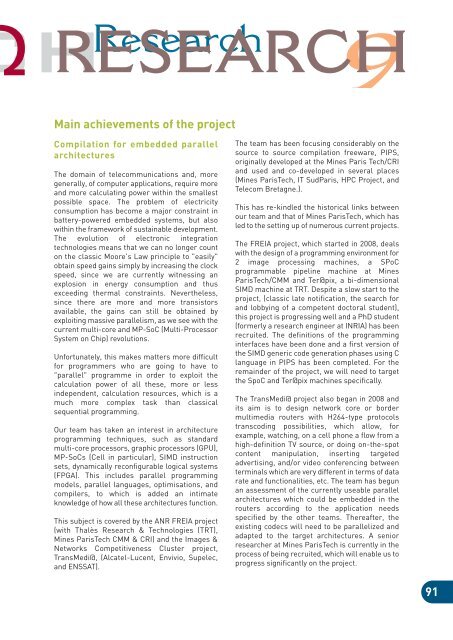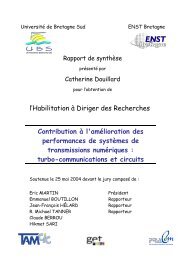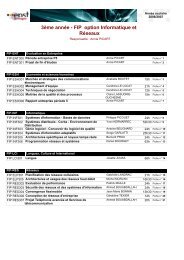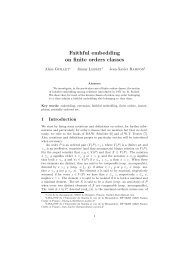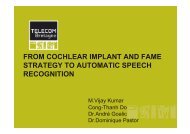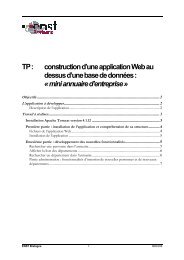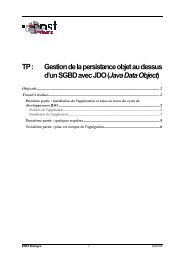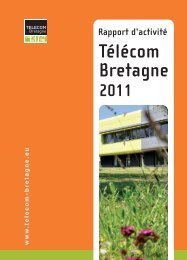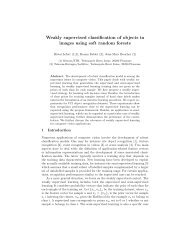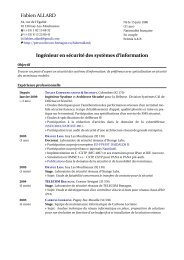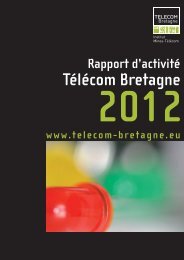researResearch - Télécom Bretagne
researResearch - Télécom Bretagne
researResearch - Télécom Bretagne
Create successful ePaper yourself
Turn your PDF publications into a flip-book with our unique Google optimized e-Paper software.
h Research<br />
9<br />
RESEARCH<br />
Main achievements of the project<br />
Compilation for embedded parallel<br />
architectures<br />
The domain of telecommunications and, more<br />
generally, of computer applications, require more<br />
and more calculating power within the smallest<br />
possible space. The problem of electricity<br />
consumption has become a major constraint in<br />
battery-powered embedded systems, but also<br />
within the framework of sustainable development.<br />
The evolution of electronic integration<br />
technologies means that we can no longer count<br />
on the classic Moore's Law principle to "easily"<br />
obtain speed gains simply by increasing the clock<br />
speed, since we are currently witnessing an<br />
explosion in energy consumption and thus<br />
exceeding thermal constraints. Nevertheless,<br />
since there are more and more transistors<br />
available, the gains can still be obtained by<br />
exploiting massive parallelism, as we see with the<br />
current multi-core and MP-SoC (Multi-Processor<br />
System on Chip) revolutions.<br />
Unfortunately, this makes matters more difficult<br />
for programmers who are going to have to<br />
"parallel" programme in order to exploit the<br />
calculation power of all these, more or less<br />
independent, calculation resources, which is a<br />
much more complex task than classical<br />
sequential programming.<br />
Our team has taken an interest in architecture<br />
programming techniques, such as standard<br />
multi-core processors, graphic processors (GPU),<br />
MP-SoCs (Cell in particular), SIMD instruction<br />
sets, dynamically reconfigurable logical systems<br />
(FPGA). This includes parallel programming<br />
models, parallel languages, optimisations, and<br />
compilers, to which is added an intimate<br />
knowledge of how all these architectures function.<br />
This subject is covered by the ANR FREIA project<br />
(with Thalès Research & Technologies (TRT),<br />
Mines ParisTech CMM & CRI) and the Images &<br />
Networks Competitiveness Cluster project,<br />
TransMedi@, (Alcatel-Lucent, Envivio, Supelec,<br />
and ENSSAT).<br />
The team has been focusing considerably on the<br />
source to source compilation freeware, PIPS,<br />
originally developed at the Mines Paris Tech/CRI<br />
and used and co-developed in several places<br />
(Mines ParisTech, IT SudParis, HPC Project, and<br />
Telecom <strong>Bretagne</strong>.).<br />
This has re-kindled the historical links between<br />
our team and that of Mines ParisTech, which has<br />
led to the setting up of numerous current projects.<br />
The FREIA project, which started in 2008, deals<br />
with the design of a programming environment for<br />
2 image processing machines, a SPoC<br />
programmable pipeline machine at Mines<br />
ParisTech/CMM and Ter@pix, a bi-dimensional<br />
SIMD machine at TRT. Despite a slow start to the<br />
project, (classic late notification, the search for<br />
and lobbying of a competent doctoral student),<br />
this project is progressing well and a PhD student<br />
(formerly a research engineer at INRIA) has been<br />
recruited. The definitions of the programming<br />
interfaces have been done and a first version of<br />
the SIMD generic code generation phases using C<br />
language in PIPS has been completed. For the<br />
remainder of the project, we will need to target<br />
the SpoC and Ter@pix machines specifically.<br />
The TransMedi@ project also began in 2008 and<br />
its aim is to design network core or border<br />
multimedia routers with H264-type protocols<br />
transcoding possibilities, which allow, for<br />
example, watching, on a cell phone a flow from a<br />
high-definition TV source, or doing on-the-spot<br />
content manipulation, inserting targeted<br />
advertising, and/or video conferencing between<br />
terminals which are very different in terms of data<br />
rate and functionalities, etc. The team has begun<br />
an assessment of the currently useable parallel<br />
architectures which could be embedded in the<br />
routers according to the application needs<br />
specified by the other teams. Thereafter, the<br />
existing codecs will need to be parallelized and<br />
adapted to the target architectures. A senior<br />
researcher at Mines ParisTech is currently in the<br />
process of being recruited, which will enable us to<br />
progress significantly on the project.<br />
91


